Coffee Equipment
Fix Your French Press: How To Assemble & Replace Parts
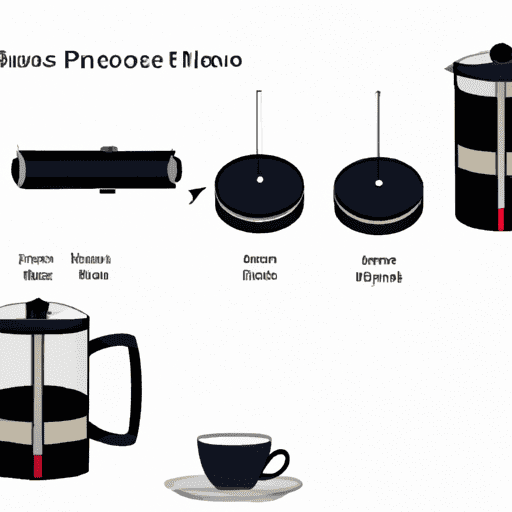
I love my French press. But like any tool, it requires proper maintenance to function at its best. That’s why I wanted to write this article about how to fix and assemble a French press.
In this guide, I’ll share my knowledge of the different components of a French press, troubleshoot common problems you may encounter, and give step-by-step instructions on assembling and disassembling your French press.
Plus, I’ll provide tips on cleaning your French press and improving the quality of your coffee by experimenting with different brewing methods.
By the end of this article, you’ll have a better understanding of how to keep your French press functioning at its best for many delicious cups of coffee to come.
Key Takeaways
- Proper assembly and maintenance of a French press is essential for optimal performance and consistent quality results.
- Choosing the right size replacement plunger and filter for your French press is important for compatibility and achieving desired taste.
- Troubleshooting common French press problems such as weak coffee, gritty coffee, and leaking can be prevented or fixed with adjustments or replacement of parts.
- Trying out different coffee brewing methods, such as pour-over or cold brew, can lead to discovering new flavors and experiences.
Understanding the Components of a French Press
So, you want to fix your French press? Well, let’s start by breaking down the components and understanding what makes up this beautiful coffee brewing device.
Understanding French Press Sizes is crucial as it determines the amount of coffee you can make in one go. French presses come in different sizes ranging from small, which can make one to two cups of coffee, to large ones that can make up to twelve cups.
Materials and Design Elements also play a significant role in determining the quality of your coffee. Most French presses are made from glass or stainless steel with some having plastic parts. The design elements include the handle, spout, base, filter assembly, and lid. The handle should be sturdy and heat resistant, while the spout should allow for easy pouring without spilling.
Choosing the Right French Press Filter is essential if you want to enjoy a cup of well-brewed coffee. There are two types of filters: metal mesh filters and paper filters. While metal mesh filters last longer than paper ones, they tend to let more sediment into your cup resulting in a gritty texture. Paper filters produce smoother coffee but need frequent replacement, which adds an additional cost element.
Now that we understand what makes up a French press, let’s move on to troubleshooting common French press problems such as clogged filters or broken glass carafes.
Troubleshooting Common French Press Problems
As a coffee lover, I’ve encountered some common problems while using my French press. One of them is weak coffee, which can be frustrating when you expect a strong and flavorful cup.
Another issue I’ve faced is gritty coffee, which can ruin the smooth texture of my brew. Lastly, leaking can also be an annoying problem that causes spills and messy cleanups.
In this subtopic, I’ll discuss how to troubleshoot these common French press problems with technical precision and knowledge.
Weak Coffee
If your coffee’s weak, you may need to adjust the grind size and brewing time. Try a finer grind and longer steeping time to increase the strength of your brew. Also, using fresher beans can improve the flavor and overall quality of your coffee. When beans sit on a shelf for too long, they lose their natural oils and become stale, resulting in less flavorful coffee.
To adjust the grind size, start by experimenting with different levels of coarseness until you find one that produces a stronger cup. You can also try increasing the brewing time by leaving it to steep for an extra minute or two.
Finally, make sure you’re using enough coffee grounds for the amount of water in your French press. A general rule of thumb is 1 tablespoon per 4 ounces of water. By following these tips, you should be able to achieve a stronger cup without sacrificing taste or quality.
Now, let’s move on to another common problem: gritty coffee.
Gritty Coffee
Getting gritty coffee can ruin your morning experience and leave you feeling disappointed with your brew. However, there are ways to prevent sediment from ending up in your cup.
Firstly, using coarse coffee grounds instead of fine ones will reduce the amount of sediment that gets through the filter. Another way to prevent grittiness is to let the coffee brew for only four minutes before pressing down on the plunger.
Leaving it longer than this will cause over-extraction and lead to a bitter taste as well as more sediment in the cup. By following these steps, you can ensure a smoother and more enjoyable cup of French press coffee without any unwanted grittiness or bitterness.
Now let’s move onto how to fix a leaking French press without having to buy a new one.
Leaking
Stop losing your precious coffee due to a leaky French press – there’s a simple solution. Leaking is a common problem with French presses, but it can be prevented and repaired with the right knowledge and techniques.
Here are some prevention methods to avoid leaks in your French press:
- Check for cracks or damage on the glass or plastic parts before use.
- Make sure all components are properly aligned and screwed tight.
- Avoid overfilling the press, as this can cause pressure that leads to leaks.
- Use coarse ground coffee instead of fine grounds that can clog the filter and cause leaks.
- Clean your French press regularly to avoid buildup that can affect its performance.
If you’re already experiencing leaking in your French press, here are some repair techniques you can try:
- Tighten all screws and connections to ensure they’re secure.
- Replace damaged or worn out parts like gaskets or filters.
- Use an adjustable wrench to tighten any loose parts that may be causing the leak.
- If the glass is cracked, replace it immediately for safety reasons.
- Consider upgrading to a higher quality French press with better materials and construction if leakage persists despite attempts at repair.
Now that we’ve covered how to prevent and fix leaks in your French press, let’s move on to assembling it properly for optimal performance.
Assembling Your French Press
When assembling my French press, I make sure to attach the plunger assembly by first inserting the metal rod into the handle and then screwing on the top.
Next, I insert the filter assembly into the carafe by pushing it down until it clicks into place.
Finally, I place the carafe onto a flat surface and ensure that it’s stable before adding in my coffee grounds and hot water.
Following these steps ensures a properly assembled French press for a perfect brew every time.
Attaching the Plunger Assembly
To attach the plunger assembly, you’ll want to make sure the filter is facing downwards. First, ensure that the top crosspiece of the plunger rod is inserted into the hole at the top of the knob. Then, insert both pieces into the press and align them with each other. Tighten screws on either side of the knob to hold everything in place. Proper lubrication will help make sure that these screws are easy to tighten and don’t get stuck.
Now that your plunger assembly is securely attached, it’s time to move onto inserting the filter assembly. This step involves placing a metal or nylon mesh filter over a plastic or metal disk and attaching it to a metal rod that runs through its center.
With this simple process complete, you’re ready to brew some delicious coffee!
Inserting the Filter Assembly
Now you’re ready to experience the rich, bold taste of freshly brewed coffee by inserting the filter assembly into your French press. First, make sure that the plunger assembly is securely attached to the lid and place it on a flat surface.
Next, insert the metal filter into the cylindrical frame and place it inside the carafe. To secure the filter assembly in place, gently press down on it until it rests firmly against the bottom of the carafe.
Ensure that there are no gaps between any of its components or else coffee grounds may slip through. Once everything is properly aligned, screw on the lid with its attached plunger assembly onto the carafe.
You’re now ready to move onto placing the carafe onto a stable surface for brewing!
Placing the Carafe
Once you have the filter assembly securely in place, it’s time to give your French press a stable home by placing it on a flat surface. Proper handling of the carafe is crucial during this step as it can easily slip and break if mishandled. Before setting the carafe down, make sure that the counter or table surface is free of any debris or liquids that may cause slipping.
It’s important to note that keeping your French press clean will not only enhance its lifespan but also improve the taste of your coffee. Cleaning technique plays a vital role in maintaining hygiene and preventing bacterial growth inside the carafe. Refer to the following table for tips on how to effectively clean different parts of your French press:
| Part | Cleaning Technique |
|---|---|
| Stainless Steel Plunger & Filter Assembly | Rinse under hot water. Use dish soap and sponge for deeper cleaning once a week. |
| Glass Carafe | Rinse with warm soapy water after each use. For stains or lingering odors, add equal parts vinegar and water, let sit for an hour before rinsing thoroughly with warm soapy water. |
| Plastic Lid & Handle | Wipe down with damp cloth after each use. Once every month, soak in hot soapy water for 10 minutes before wiping down again. |
Next up is disassembling your French press which involves removing all parts from their respective positions safely without causing damage or injury.
Disassembling Your French Press
First, you’ll need to grab a screwdriver and brace yourself for the satisfying feeling of taking apart your French press. The disassembling process can seem intimidating at first, but it’s actually quite simple.
Start by unscrewing the plunger assembly from the top of the rod. Then, remove the metal filter screen and spiral plate from inside the assembly. One common mistake people make when disassembling their French press is not paying attention to how each part fits together.
Take note of where each piece goes as you remove them so that you can easily reassemble everything later on. Another mistake is using too much force when unscrewing certain parts. Be gentle to avoid damaging anything.
Now that your French press is completely disassembled, it’s time to move onto replacing the plunger assembly. But before we get into that, let’s take a closer look at each individual part and how they work together to make a perfect cup of coffee.
Replacing the Plunger Assembly
When replacing the plunger assembly in my French press, there are three key points I need to keep in mind.
First, it’s important to choose the right size replacement plunger for my specific French press model.
Second, I must properly attach the new plunger by aligning and securing it into place within the carafe.
And finally, I should test the functionality of my French press to ensure that everything is working correctly before using it again.
Choosing the Right Size
To ensure you select the appropriate size for your French press, it’s essential to consider how much coffee you typically brew and how many servings you require. Here are some factors to consider when selecting the right size for your needs:
- French press capacity: The capacity of a French press is measured in cups or ounces. Consider how much coffee you need to brew at once and choose a capacity that accommodates that.
- Number of servings: Think about how many people will be served from one batch of coffee brewed in your French press. This will help determine the size needed.
- Personal preference: Some people prefer stronger or weaker coffee, so adjust the size accordingly.
- Storage space: Keep in mind where you’ll store the French press when not in use and choose a size that fits comfortably in that space.
Now that you’ve selected the appropriate size for your French press, it’s time to attach the new plunger assembly.
Attaching the New Plunger
Now that you’ve got the right size French press, let’s get started on attaching the new plunger.
First things first, make sure your new plunger is compatible with your French press model. Check to see if it fits snugly and securely into the cylinder. If there are any gaps or wobbling, it may not be the right fit.
Once you’ve confirmed compatibility, follow this step-by-step attachment process: First, insert the filter screen onto the bottom of the plunger. Then slide the rod through the center of both pieces until it reaches the top of the cylinder. Finally, screw on the knob to secure everything in place.
With these simple steps, your French press should be good as new! Next up, let’s test out its functionality by brewing a fresh cup of coffee.
Note: It’s important to ensure that all parts are fully tightened and secured before using your French press to avoid leaks or accidents when pouring hot liquids.
Testing the Functionality
You’re ready to see just how amazing your freshly repaired French press is, so get ready to taste the most delicious coffee you’ve ever had! Before you pour in hot water and start brewing, it’s important to test the functionality of your French press.
There are a few testing methods that can help ensure your equipment is calibrated correctly. One way to test the functionality of your French press is by checking the plunger’s seal. Fill up the carafe with hot water and let it sit for a few minutes before pressing down on the plunger. If you notice any leaks or resistance when pushing down, then there may be an issue with the seal or alignment of parts.
Another method involves calibrating your equipment by weighing out coffee grounds and measuring water temperature. By following these testing methods and equipment calibration, you can guarantee that your French press will function properly and produce great-tasting coffee every time.
Now that you’ve tested the functionality of your French press, it’s time to move onto replacing the filter assembly.
Replacing the Filter Assembly
Now that I’ve replaced the plunger assembly in my French press, it’s time to focus on replacing the filter assembly.
The first step is choosing the right type of filter, whether it be metal or nylon mesh.
Next, I’ll need to install the new filter properly and make sure it functions correctly by testing it with hot water before using it for brewing coffee.
Choosing the Right Type of Filter
Picking out the perfect filter for your French press can make all the difference in achieving that smooth, rich cup of coffee you crave. When it comes to choosing between a metal or mesh filter, it’s important to consider how each option affects your coffee flavor.
Here are some factors to keep in mind:
- Metal filters tend to be more durable and long-lasting than their mesh counterparts. They also allow more oils and sediment through, which can give your coffee a fuller body and richer taste.
- Mesh filters are typically finer and more delicate than metal ones. They do a better job of catching sediment and producing a cleaner cup of coffee with less residual grounds.
Another factor to consider is the shape of your filter. Some French presses come with dome-shaped filters, while others have flat ones. The shape can impact how evenly the water is distributed over the coffee grounds, which can affect the overall flavor of your brew.
When choosing a filter for your French press, take some time to think about what matters most to you – whether that’s durability, richness of flavor, or ease of cleanup.
Once you’ve made your choice, it’s time to install the new filter and get brewing!
Installing the New Filter
To make sure your coffee is the best it can be, it’s time to show you how to easily install the new filter in your French press. Proper maintenance is key to ensuring that your French press lasts for years and produces the highest quality coffee possible.
Filter maintenance is especially important as it directly affects the taste and clarity of your brew. When installing a new filter, start by disassembling your French press and removing the old filter. Make sure to clean any residue or debris from both the plunger and filter holder before inserting the new filter.
Align the new filter with the bottom of the filter holder and place it into position. Once in place, carefully screw on the plunger until it reaches its limit without applying too much force. With proper installation, you should experience a smooth plunging motion that will not cause any resistance or difficulties when making coffee.
Now that you’ve installed a new filter in your French press, it’s time to test its functionality by brewing a fresh cup of coffee!
Testing the Functionality
After installing the new filter, it’s time to put your French press to the test and see if it’s up to par with your coffee standards. Don’t let a bad cup of joe rain on your parade! Here are four steps to follow when testing the accuracy and measuring consistency of your French press:
- Start by boiling water in a kettle or pot until it reaches around 200°F (just below boiling point).
- Grind enough coffee beans for one cup of coffee, using a coarse grind setting.
- Place the ground coffee into the French press, pour hot water over it, stir gently, and then place the lid on top with the plunger pulled up.
- Wait for around 4 minutes before slowly pressing down on the plunger.
If you find that there is any sediment or grit in your cup after pouring from the French press, this could indicate that either too much coffee was used or that the filter is not performing as expected.
If there is no sediment and you’re happy with both taste and strength of your coffee – congratulations! Your newly assembled French press passes our functionality test.
Now that we’ve tested our freshly assembled French Press, let’s move onto cleaning it properly so that we can continue enjoying great tasting coffee every time we use it.
Cleaning Your French Press
Now that you’ve enjoyed your freshly brewed coffee, it’s time to tackle the task of cleaning your French press to ensure it’s ready for your next cup. Deep cleaning is essential to remove coffee residue and prevent any lingering tastes or smells from affecting future brews. Start by disassembling the French press and rinsing the parts under hot water.
To deep clean, use a mixture of warm water and dish soap to soak all the parts for at least 15 minutes. Use a scrub brush or sponge to thoroughly clean each piece, paying extra attention to the mesh filter and plunger. Rinse everything well under running water and allow it to air dry before reassembling.
Improving the quality of your French press coffee requires not only proper assembly but also regular maintenance. By keeping your French press clean, you’ll ensure that every cup is free from residual flavors or oils that can affect taste. Plus, you’ll prolong the life of your French press, so it continues brewing perfection for years to come!
Improving the Quality of Your French Press Coffee
Enhance the flavor of your morning brew with these simple tips for better French press coffee. One of the most important factors in achieving a high-quality cup is using the right brewing techniques.
Firstly, make sure you’re using freshly roasted beans that have been ground specifically for French press brewing. The optimal grind size should be coarse, similar to sea salt, which allows for proper extraction and prevents over-extraction or bitterness.
Next, consider experimenting with different water temperatures. Most experts recommend using water that’s just below boiling point (around 200°F), but some prefer slightly cooler or hotter water depending on personal preference and bean type.
Additionally, try blooming the coffee by pouring a small amount of hot water over the grounds and allowing them to sit for 30 seconds before adding more water – this can enhance the aroma and overall taste of your brew.
By following these brewing tips and adjusting to your own taste preferences, you’ll be able to enjoy a perfectly brewed cup of French press coffee every time.
However, don’t be afraid to experiment with different brewing methods as well – such as cold brew or pour-over – to find what works best for you and your palate.
Experimenting with Different Brewing Methods
Trying out new brewing methods can lead to a whole new world of coffee flavors and experiences – did you know that iced coffee sales have increased by 75% in the past decade? As a coffee enthusiast, I love trying variations and perfecting techniques to achieve the best cup of joe. One way to do this is by exploring flavor profiles through different brewing methods.
Here’s a table that shows some popular brewing methods and their unique characteristics:
| Brewing Method | Characteristics |
|---|---|
| French Press | Full-bodied, rich flavor with sediment at the bottom |
| Pour Over | Clean, bright taste with subtle nuances |
| Espresso | Bold, concentrated shot with crema on top |
| Cold Brew | Smooth, less acidic taste with longer brew time |
| Aeropress | Versatile method that can produce espresso-like shots or pour over-style coffee |
By experimenting with these different methods, you may discover new favorite flavors or ways of preparing your coffee. For example, using a French press could bring out deeper notes in your beans while a pour over might highlight more delicate flavors. It’s all about finding what works best for your personal taste preferences.
Exploring various brewing methods is an exciting way to enhance your coffee experience and discover new flavor profiles. However, it’s important to remember that proper maintenance and longevity of your equipment are essential for consistent quality results. Let’s move onto how to assemble and replace parts in order to keep our French presses running smoothly.
Maintenance and Longevity
To keep your French press functioning smoothly for years to come, it’s crucial to take good care of your brewing equipment. Here are some tips for maintenance and extending the lifespan of your French press:
Firstly, clean your French press after every use. Take apart all the parts and wash them with soap and water. Make sure you remove any coffee grounds that may be stuck in the mesh filter. If you notice any cracks or chips in the glass carafe or plastic components, replace them immediately.
Secondly, avoid using harsh detergents or abrasive sponges when cleaning your French press. These can damage the mesh filter and other delicate parts of your brewing equipment. Instead, use a soft cloth or sponge to gently scrub away any residue.
Lastly, store your French press in a dry place where it won’t be exposed to extreme temperatures or moisture. This will help prevent rusting and other types of damage that can shorten its lifespan.
By following these simple tips for maintenance, you can ensure that your French press continues to function optimally for many years to come!
Frequently Asked Questions
How do I choose the right size French press for my needs?
When choosing the right French press size for your needs, it’s important to consider the capacity comparison. Different sizes of French presses can vary in their brewing capacity, which typically ranges from 3 to 12 cups.
It’s important to assess how much coffee you’ll be making at once and choose a size that fits that need. If you’re just making coffee for yourself or one other person, a smaller French press size may suffice. However, if you’re brewing for a larger group or enjoy multiple cups throughout the day, a larger size may be more appropriate.
Ultimately, it comes down to balancing your personal preferences with practicality and functionality when determining which French press size is right for you.
Can I use pre-ground coffee in a French press or should I grind my own beans?
When it comes to using pre-ground coffee in a French press, there are pros and cons to consider. On the one hand, pre-ground coffee is convenient and requires no extra effort on your part. However, since the grounds have already been exposed to oxygen, they may have lost some of their flavor and aroma.
Whole beans, on the other hand, retain their freshness longer and can be ground just before brewing for maximum flavor. If you do choose to use pre-ground coffee in your French press, there are tips you can follow to achieve optimal flavor.
First, make sure you use a coarser grind size than you would for drip or espresso machines. This will help prevent over-extraction and bitterness. Additionally, be sure to store your pre-ground coffee in an airtight container away from light and heat sources to preserve its freshness as much as possible.
How do I know when it’s time to replace the mesh filter in my French press?
Replacing the mesh filter in a French press can be daunting, but it’s essential for perfect coffee. One common problem is clogging due to coffee grounds buildup in the mesh filter. This can affect taste and texture.
To determine if it’s time to replace the mesh filter, inspect it for signs of wear and tear such as holes or fraying edges. If you notice any damage, it’s time to replace the filter. You can do this by unscrewing the plunger assembly and removing the old filter.
Always keep an extra mesh filter handy so that you don’t have to go without your morning cup of joe while waiting for a new one to arrive. Remember, a stitch in time saves nine.
In summary, staying on top of maintenance and replacement issues will ensure that your French press continues to produce delicious coffee every day without any hiccups or unwanted particles floating around in your cup.
Can I use my French press to make tea or other beverages besides coffee?
Yes, you can use a French press to make tea or other beverages besides coffee. Making tea in a French press is actually quite simple and produces a delicious cup with minimal effort.
To make tea in a French press, start by adding loose leaf tea or tea bags to the bottom of the press. Then, pour hot water over the top and let steep for several minutes. Once steeped, slowly push down the plunger to separate the leaves from the liquid.
Other beverages that can be made in a French press include cold brew coffee, infused waters, and even cocktails. The versatility of this kitchen tool makes it an essential addition to any home barista or mixologist’s collection.
How do I adjust the brewing time and water temperature to get the best results with my French press?
When it comes to getting the best results with your French press, there are a few key factors to consider.
First and foremost, adjusting the grind size of your coffee beans can have a significant impact on the flavor and strength of your brew.
Experimenting with different steeping times can also help you find the perfect balance between boldness and smoothness.
Additionally, paying attention to water temperature is crucial for achieving optimal extraction.
By making small adjustments to these variables, you can fine-tune your brewing process and create a truly delicious cup of coffee every time.
Conclusion
In conclusion, fixing your French press is an easy task that can improve the quality of your coffee and extend the lifespan of your brewing device. Assembling and disassembling your French press may seem daunting at first, but with practice, it becomes second nature. By troubleshooting common problems and replacing parts as needed, you can ensure that your French press works like new for years to come.
Imagine waking up on a lazy Sunday morning to the sound of water boiling in the kettle. You reach for your trusty French press and begin assembling it piece by piece, relishing in the satisfying clicks and clacks of each component fitting perfectly together.
With every pour of hot water over freshly ground beans, you savor the rich aroma wafting from the brewing chamber. The end result? A perfect cup of coffee that you brewed yourself with precision and care thanks to your well-maintained French press.
So take pride in being a master brewer and fix that French press today!
Arf, an author and an innovative enthusiast of coffee, coffee alternatives, and tea, plays a crucial role as a contributor to the esteemed Cappuccino Oracle platform. Renowned for his curiosity and passion for these captivating beverages, Arf has carved out a unique space for himself in the world of exploration and writing. He realized that coffee, coffee alternatives, and tea are not mere drinks to keep one awake, but universes of flavors and stories waiting to be explored.
Arf’s articles for Cappuccino Oracle blend meticulous research with personal experiences, providing readers with an in-depth understanding of various types of coffee, coffee alternatives, and tea, along with their unique characteristics, cultures, and histories. His honest reviews and engaging narratives guide readers on their own journeys, helping them discover their preferences and find their perfect brew.
Nespresso
How to Make Iced Coffee at Home With Nespresso
Frothy milk, flavored syrups, and seasonal fruits are just the beginning of creating your perfect homemade iced coffee with Nespresso – keep reading for more tips on elevating your brew!

So, you wanna make iced coffee with your Nespresso, huh? Well, grab a tall glass, fill it with ice, and brew a Cold Brew Style Intense capsule. Let that brew cool, then add milk. Fancy frothy milk? Use the Aeroccino. Experiment with different capsules for unique flavors. Try whole milk or go light with almond milk. Sweeten with syrups like vanilla or hazelnut. Top with berries or season fruits. Add a stylish straw for fun. Want more tips? Keep discovering to level up your homemade iced coffee game!
Key Takeaways
- Start with a 500ml glass, 6 ice cubes, and Nespresso Cold Brew Style Intense capsules.
- Chill brewed coffee before adding milk and sweeteners.
- Froth cold milk with Nespresso Aeroccino.
- Experiment with different Nespresso capsules for flavor variations.
- Use whole milk or try plant-based options, like oat or almond milk, for customization.
Nespresso Vertuo Brewing Basics
When brewing with a Nespresso Vertuo machine, ensuring the glass is twice the size of your drink enhances the iced coffee experience. This trick allows enough room for ice cubes and prevents your delicious coffee from overflowing.
For a perfect iced coffee, start with a 500ml glass and add six regular-sized ice cubes before brewing your Nespresso Vertuo coffee. I recommend using Nespresso Vertuo Cold Brew Style Intense capsules like Arpeggio for that extra kick.
Once brewed, let the coffee cool down before adding any milk or sweeteners. This way, you'll enjoy a revitalizing iced coffee that's not diluted by melting ice. The Nespresso Vertuo machine's quantity selector also comes in handy here, ensuring you get the right coffee-to-ice ratio every time.
Experiment with different recipes and milk options to find your favorite combination for a custom iced coffee experience right at home.
Chilling and Frothing Techniques

Cool your brewed coffee in the fridge before adding milk for an invigorating iced coffee experience. When making that perfect iced coffee at home with Nespresso, chilling and frothing techniques play an important role. The Nespresso Aeroccino milk frother is a game-changer, allowing you to froth cold milk to create a creamy topping for your iced coffee. Additionally, using ice cubes in your glass before brewing your coffee helps to chill the drink quickly, preserving its flavors.
Here's a handy table to summarize the chilling and frothing techniques for your Nespresso iced coffee:
| Chilling Techniques | Frothing Techniques |
|---|---|
| Chill brewed coffee in the fridge | Utilize Nespresso Aeroccino for cold milk froth |
| Use ice cubes in the glass before brewing | Experiment with different Nespresso capsules for flavor |
Selecting the Perfect Milk
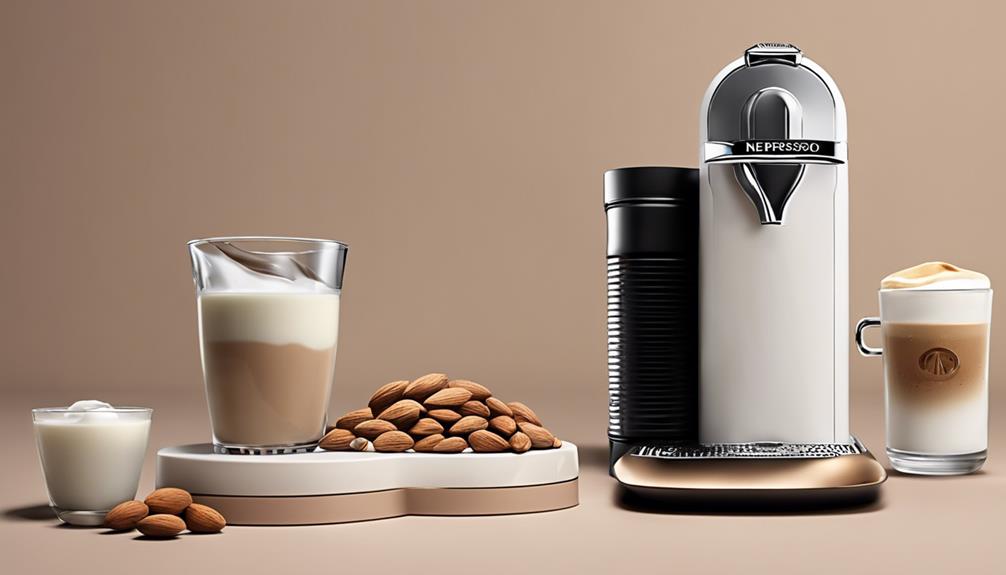
Selecting the perfect milk is crucial for achieving the desired creamy texture and flavor in your homemade iced coffee. For a lusciously creamy iced coffee, opt for whole milk or cream. These choices bring a richness that blends magically with the coffee, creating a decadent treat.
If you lean towards a lighter option, explore low-fat or plant-based milks like almond, oat, or soy milk. These alternatives offer a different take, keeping things fresh and exciting. It's fascinating how the type of milk you choose can influence the flavor profile of your iced coffee. Experimenting with different milks opens up a world of possibilities, letting you tailor your drink precisely to your liking.
To elevate your iced coffee game, froth your milk with a Nespresso Aeroccino for that touch of luxury and velvety foam. And if you're feeling adventurous, try a sweetened condensed milk for a rich and sweet twist that will make your iced coffee truly unforgettable.
Sweeteners and Flavor Enhancements
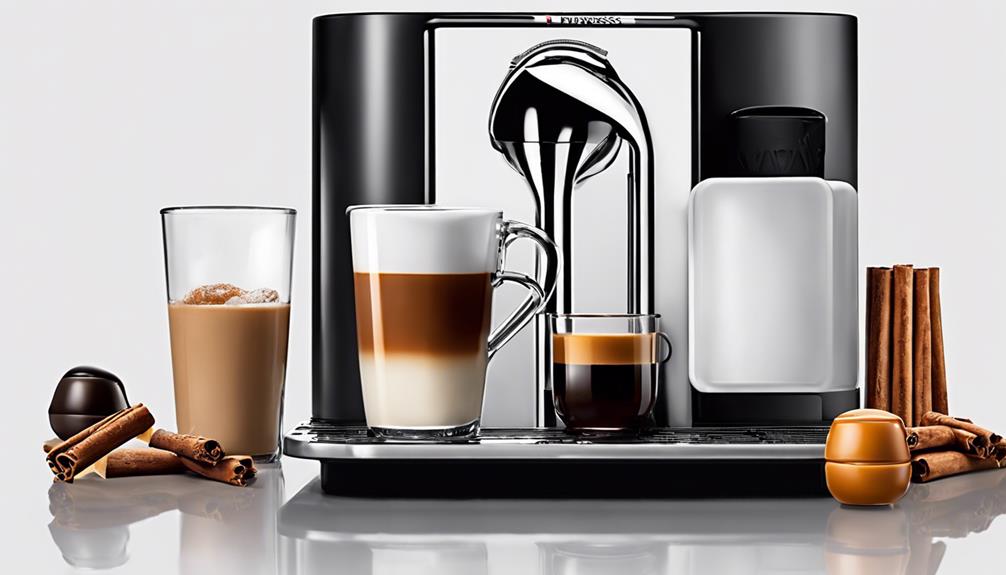
To enhance the flavor of your homemade iced coffee, consider experimenting with various sweeteners and flavor enhancements. Here are some exciting options to jazz up your Nespresso creation:
- Maple Syrup: Add a touch of natural sweetness with maple syrup, giving your iced coffee a rich and decadent flavor profile.
- Sugar-Free Syrups: For those watching their sugar intake, try sugar-free syrups in flavors like vanilla, caramel, or hazelnut for a guilt-free treat.
- Brown Sugar: Infuse a warm and caramel-like taste by incorporating brown sugar into your iced coffee, creating a cozy and comforting drink.
- Honey or Agave Nectar: Opt for the goodness of honey or agave nectar as healthier alternatives to traditional sugar, bringing a subtle sweetness that complements the coffee's bold flavors perfectly.
Experimenting with these sweeteners and flavor enhancers will elevate your Nespresso iced coffee experience, allowing you to customize your drink to suit your taste preferences.
Creative Nespresso Capsule Combinations
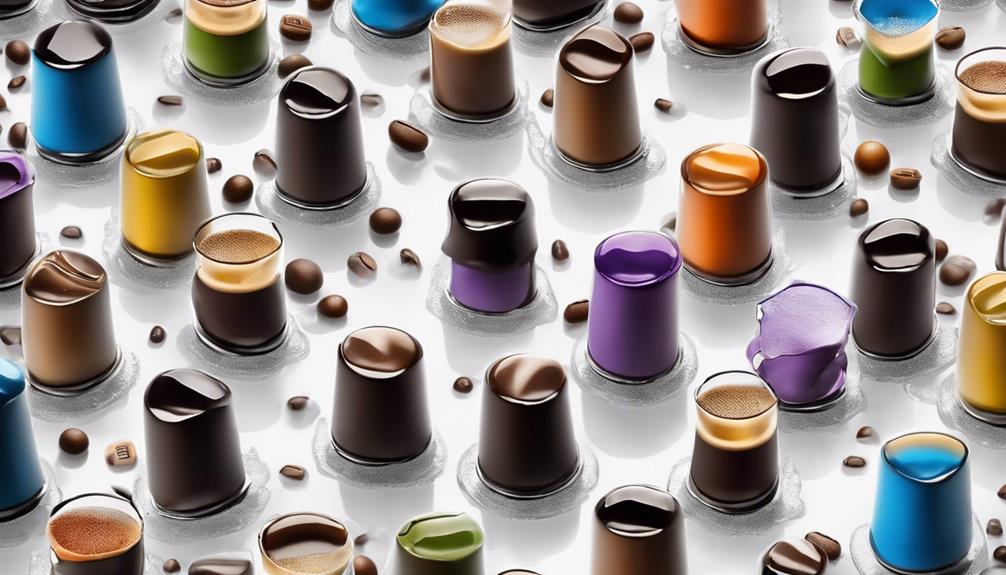
Experimenting with different Nespresso capsule combinations can add a unique and invigorating twist to your homemade iced coffee creations.
I love mixing Nespresso capsules like Odacio and Firenze Arpeggio for a burst of rich flavors in my iced coffee. If you're feeling adventurous, try combining Arpeggio and Livanto for a delightful taste experience that will elevate your morning pick-me-up.
For a tropical vibe, the Nespresso Tropical Coconut capsule is a must-try, while the Ice Forte and Ice Leggero capsules offer revitalizing options for a hot summer day. Don't miss out on the new releases like Watermelon Flavour Over Ice and Cold Brew Style Intense; they bring a whole new level of excitement to your coffee routine.
When choosing capsules, opt for bold and intense flavors like Kazaar, Arpeggio, or Ristretto for a satisfying iced coffee that packs a punch. Get creative and mix things up to discover your perfect iced coffee combination!
Experimenting With Different Milk Types

My go-to choice for a creamy and dairy-free option to enhance the bold flavors of Nespresso coffee is oat milk. When exploring different milk types for your iced coffee, it's like venturing on a flavorful journey where each sip uncovers new possibilities. Here are some reasons why playing with milk types can elevate your iced coffee experience:
- Oat Milk: Creamy and rich, oat milk pairs exquisitely with Nespresso's robust coffee, giving your drink a velvety texture that feels like a cozy hug in a glass.
- Almond Milk: For a lighter touch, almond milk introduces a subtle nuttiness that dances gracefully with the coffee's flavors, offering a delicate twist to your usual iced coffee routine.
- Soy Milk: Versatile and creamy, soy milk is like a blank canvas, ready to absorb the intense notes of Nespresso's coffee blends, creating a harmonious and luscious iced coffee experience.
- Personalized Experience: By customizing your milk choice, you tailor your iced coffee to suit your preferences, ensuring each sip is uniquely yours, adding a touch of creativity to your daily routine.
Customizing With Toppings and Garnishes

Enhance your iced coffee experience with a variety of toppings and garnishes that add a touch of luxury and creativity to your drink. When it comes to customizing your homemade Nespresso iced coffee, the options are endless! Think beyond the usual whipped cream and chocolate shavings – why not try a drizzle of caramel for that extra indulgence or some fresh mint leaves for a burst of flavor? Garnishes like cinnamon sticks or citrus zest can elevate your drink, making it not only delicious but also visually appealing.
Experimenting with different flavors is key to finding your perfect combination. Sprinkle some cocoa powder, nutmeg, or a pinch of sea salt on top to enhance the taste profile of your iced coffee. By personalizing your drink with unique toppings and garnishes, you can create a signature beverage that truly reflects your style and creativity. So go ahead, get creative, and take your iced coffee to the next level!
Serving Suggestions and Presentation Ideas

When it comes to serving your homemade iced coffee, think about jazzing it up with some fresh fruit garnishes for a pop of color and flavor.
Don't forget to grab some decorative straws to add a fun touch to your presentation.
And if you're feeling fancy, consider drizzling in some flavored syrups for that extra oomph!
Garnish With Fresh Fruit
Incorporating fresh fruit garnishes elevates the visual appeal and taste of your Nespresso iced coffee. Here are some innovative ideas to enhance your iced coffee experience:
- Colorful Citrus Twist: Try garnishing with slices of lime or grapefruit for a tangy kick that complements the rich flavors of your Nespresso creation.
- Berry Burst: Add a burst of sweetness by topping your iced coffee with assorted berries like strawberries, raspberries, or blueberries.
- Seasonal Sensations: Embrace the flavors of the season by using fresh seasonal fruits like peaches in the summer or apples in the fall to create a drink that's both visually appealing and delicious.
- Creative Combos: Mix and match different fruits to create visually stunning presentations that not only look great but also tantalize your taste buds.
Use Decorative Straws
Often overlooked, decorative straws can instantly elevate the presentation of your iced coffee, adding a touch of fun and style to your beverage. When choosing your straws, consider picking vibrant colors, playful patterns, or unique materials to match your personality or the occasion. Striped, polka dot, metallic, or eco-friendly reusable straws are all the rage for serving iced coffee. Opt for sustainable options like bamboo, paper, stainless steel, or glass straws to align with environmentally conscious choices. Using these stylish straws not only enhances the visual appeal of your drink but also makes it Instagram-worthy. Elevate your iced coffee game with these small yet impactful details that are both fun and sustainable.
| Colors | Patterns | Materials |
|---|---|---|
| Vibrant | Striped | Bamboo |
| Playful | Polka dot | Paper |
| Unique | Metallic | Stainless steel |
| Glass | ||
| Reusable eco-friendly |
Add Flavored Syrups
To further enhance the flavor profile and presentation of your iced coffee, consider incorporating flavored syrups for a delightful twist on your beverage. Here are some fun ways to customize your drink:
- Vanilla Dream: Add a splash of vanilla syrup for a classic and sweet flavor.
- Caramel Bliss: Indulge in the rich and buttery notes of caramel syrup swirled into your iced coffee.
- Hazelnut Heaven: Elevate your drink with the nutty and aromatic essence of hazelnut syrup.
- Mocha Magic: Experience the decadence of chocolate and coffee with a drizzle of mocha syrup on top.
Tips for a Refreshing Iced Coffee Experience
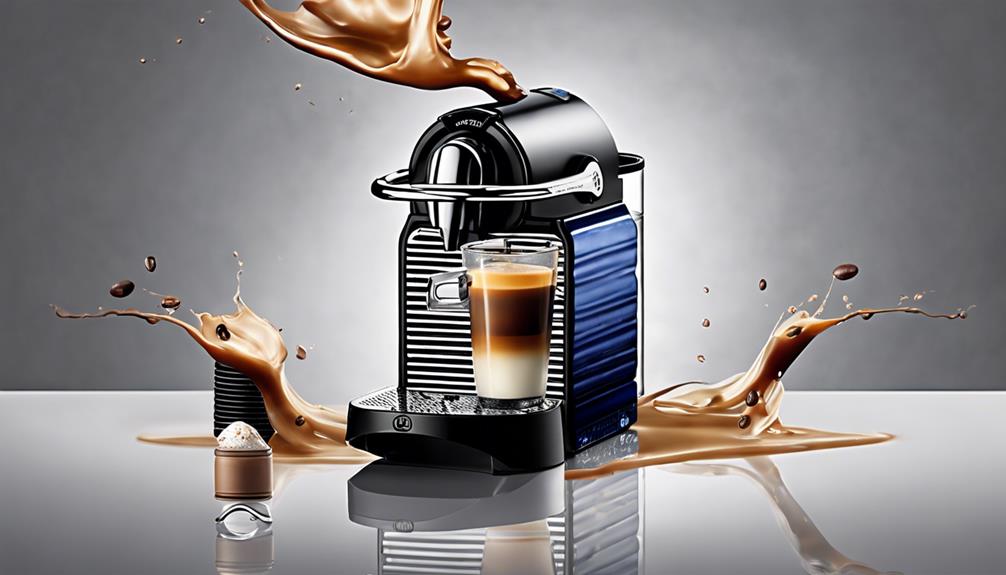
For a truly revitalizing iced coffee experience, opt for low-acid, dark roast Nespresso capsules like Kazaar or Arpeggio. These capsules pack a flavorful punch, perfect for creating a robust and satisfying iced coffee. If you're feeling adventurous, try out new releases like Watermelon Flavour Over Ice or Cold Brew Style Intense capsules for a unique twist on your usual iced coffee routine.
To enhance your homemade iced coffee, consider adding syrups, spices, or cold milk to customize it to your taste preferences. The possibilities are endless when it comes to personalizing your invigorating drink. Don't forget to leverage the Nespresso Barista for versatile recipes and easy customization of flavors and ingredients. It's like having your own personal barista at home, ready to help you craft the perfect iced coffee for those hot days when you need a cool pick-me-up.
| Tips for Revitalizing Iced Coffee |
|---|
| Opt for low-acid, dark roast Nespresso capsules like Kazaar or Arpeggio |
| Experiment with new releases like Watermelon Flavour Over Ice or Cold Brew Style Intense capsules |
| Customize your iced coffee with syrups, spices, or cold milk |
Enjoying Your Homemade Iced Coffee
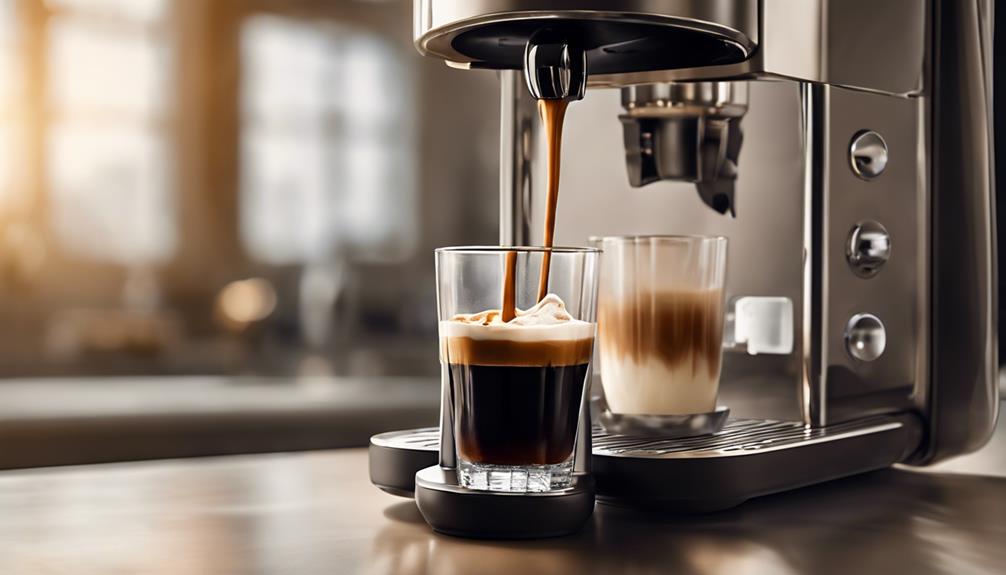
I've found that serving your homemade iced coffee with style can really elevate the whole experience.
Experimenting with different flavors like caramel, vanilla, or even a splash of cinnamon can add a fun twist to your drink.
Serving With Style
Savor the stylish experience of enjoying your homemade iced coffee by serving it in Nespresso Recipe glasses. When it comes to serving your invigorating beverage, presentation is key.
Elevate your homemade iced coffee with Nespresso Espresso Cups & Saucers for a sophisticated touch. Create a visually appealing experience using Nespresso's specially designed VIEW Recipe Glasses.
Choose between a 12 oz. glass or an 8 oz. mug for a satisfying and stylish serving encounter. Enhance the overall enjoyment of your beverage by serving it in a visually appealing manner.
With the right glassware, every sip becomes a moment of indulgence and innovation. It's not just a drink; it's a whole experience!
Experiment With Flavors
Elevate your homemade iced coffee experience by infusing it with a variety of flavors to suit your taste preferences. Get creative with Nespresso capsules like Kazaar, Arpeggio, or Ristretto to craft unique iced coffee creations.
Experiment with syrups, spices, cold milk, or cream to customize your drink just the way you like it. Want to take it up a notch? Add a dollop of whipped cream or a scoop of ice cream for an indulgent twist.
The possibilities are endless when it comes to enhancing the flavors of your homemade iced coffee. So go ahead, mix and match, and find that perfect blend that will have you sipping in style all summer long!
Frequently Asked Questions
Can You Make Iced Coffee With a Nespresso Machine?
Yes, I can make iced coffee with a Nespresso machine. Nespresso offers specific capsules like Kazaar, Arpeggio, and Ristretto for a flavorful iced coffee. Using the Vertuo machine or pouring espresso capsules over ice creates a quick and invigorating cold brew effect.
How Many Nespresso Pods for Iced Coffee?
Finding the perfect balance of Nespresso pods for iced coffee is key. Depending on your preference, I recommend experimenting with 1-2 capsules. The variety of capsules available allows for customizing your iced coffee's strength and flavor.
How Do You Make Coffee With Nespresso Vertuo?
To make coffee with Nespresso Vertuo, use the appropriate capsule and cup size. Start by placing the cup and pressing the brew button. Enjoy freshly brewed coffee in seconds. It's easy, convenient, and delivers a delicious coffee experience every time.
Why Is My Nespresso Making Cold Coffee?
My Nespresso making cold coffee could be due to water temperature settings. Verify adequate water level in the reservoir with cold water. If issue persists, contact Nespresso support for help to troubleshoot and resolve the problem.
Conclusion
Well, there you have it – making iced coffee at home with Nespresso is easier than you think!
Did you know that iced coffee has become increasingly popular, with a 20% increase in consumption over the past decade?
So why not try your hand at crafting your own delicious and revitalizing iced coffee creations?
With these simple steps and tips, you'll be sipping on a homemade iced coffee masterpiece in no time!
Cheers to your barista skills!
In the vast and diverse world of coffee, coffee alternatives, and tea, Olivia has found her calling. As an author and a dedicated coffee and tea aficionado, her work for Cappuccino Oracle reflects her profound love and understanding of the intricate complexities found within these beverages. Olivia’s passion for the subject serves as both a catalyst for her creativity and a connection point with her audience.
Olivia’s appreciation for coffee, coffee alternatives, and tea blossomed at an early age. She discovered that these beverages invigorated her senses and stimulated her creative spirit. From the nuanced flavors of single-origin roasts to the captivating narratives intertwined with coffee, coffee alternatives, and tea trade and culture, Olivia found an unlimited source of inspiration in her daily cup.
Her love for these beverages and her talent for storytelling eventually converged at Cappuccino Oracle. As an author, Olivia’s mission is to illuminate the intricate tapestry that makes up the world of coffee, coffee alternatives, and tea. Her articles span a diverse range of topics, encompassing everything from the unique flavors of different brews to the sociocultural history intertwined with their cultivation and consumption.
Nespresso
How to Remove Nespresso Descaling Mode in 3 Simple Steps
Find out how to effortlessly eliminate Nespresso's descaling mode with just three easy steps and get your machine back to brewing perfection.
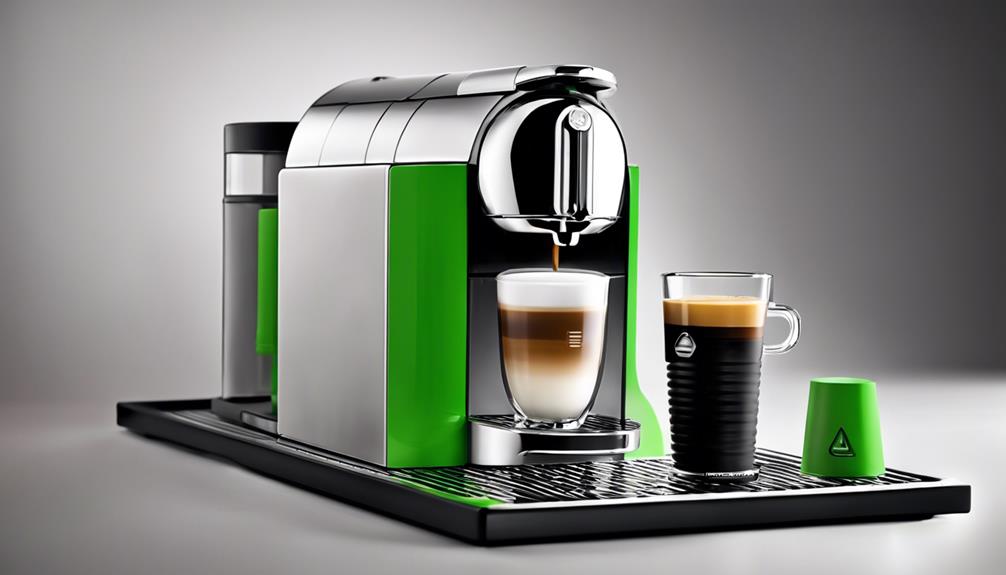
Removing Nespresso's descaling mode is a breeze! First, make sure you're all set up with a container in place and the water tank full. Then, activate the descaling mode using the specific button combo for your Nespresso model. Let the magic happen as it cleans out those calcium deposits. After that, give it a final rinse with fresh water to get rid of any leftover solution. Voilà! Your machine is now free from descaling mode and ready to brew. Get those beans ready for a delightful cup of joe!
Key Takeaways
- Perform final rinse with fresh water to eliminate descaling solution remnants.
- Refill water tank and let water run through the machine to ensure cleanliness.
- Automatic exit from descaling mode occurs after final rinse completion.
- Ensure no descaling solution residue remains to maintain optimal coffee flavor.
- Complete proper rinsing to restore machine to regular functionality.
Preparation Steps
I'll get the container ready to catch any water or descaling solution that may come out during the process. It's like preparing for a mini science experiment with our Nespresso machines. Ensuring we've everything in place before diving into the descaling mode is key. Imagine the water tank filled to the brim, ready to battle any limescale buildup. It's like giving our Nespresso buddy a rejuvenating spa day!
Positioning the machine securely on a stable surface is vital. We don't want any unexpected acrobatics during the descaling dance. Safety first, folks! Oh, and don't forget to unplug the power cord. We're going green, not sparking! Let's keep those electrical mishaps at bay.
With our container at the ready, water tank filled, and machine securely positioned, we're all set for the descaling adventure. These preparation steps might seem essential, but they're the foundation for a successful descaling mission. Let's get ready to bid adieu to that pesky limescale!
Descaling Mode Activation
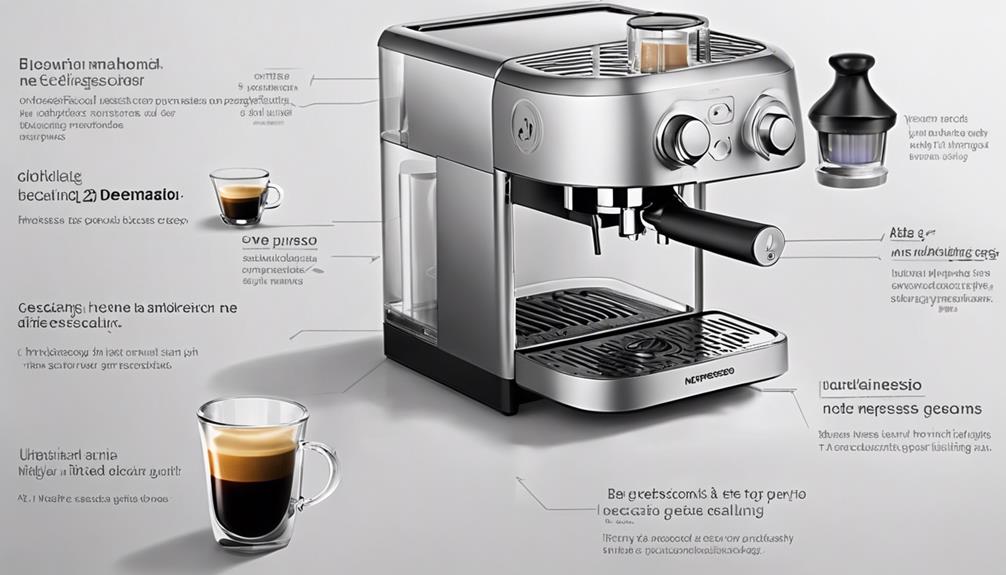
After preparing the necessary materials and ensuring the machine is securely positioned, activating the descaling mode on Nespresso Original Machines involves specific button combinations. To put your Nespresso machine into descaling mode, you'll need to press a sequence of buttons that vary depending on the model. Below is a handy table to guide you through the process:
| Nespresso Model | Descaling Mode Activation |
|---|---|
| Essenza Mini | Press both buttons simultaneously for 3 seconds. |
| Pixie | Hold down Lungo and Espresso buttons for 5 seconds. |
| CitiZ | Simultaneously press both buttons for 3 seconds. |
| Inissia | Press both buttons for 2 seconds. |
These button combinations trigger the descaling mode, allowing your machine to begin the cleaning process and remove any built-up calcium or lime deposits. Remember, following the correct steps is essential for maintaining your Nespresso machine's performance.
Final Rinse and Exit
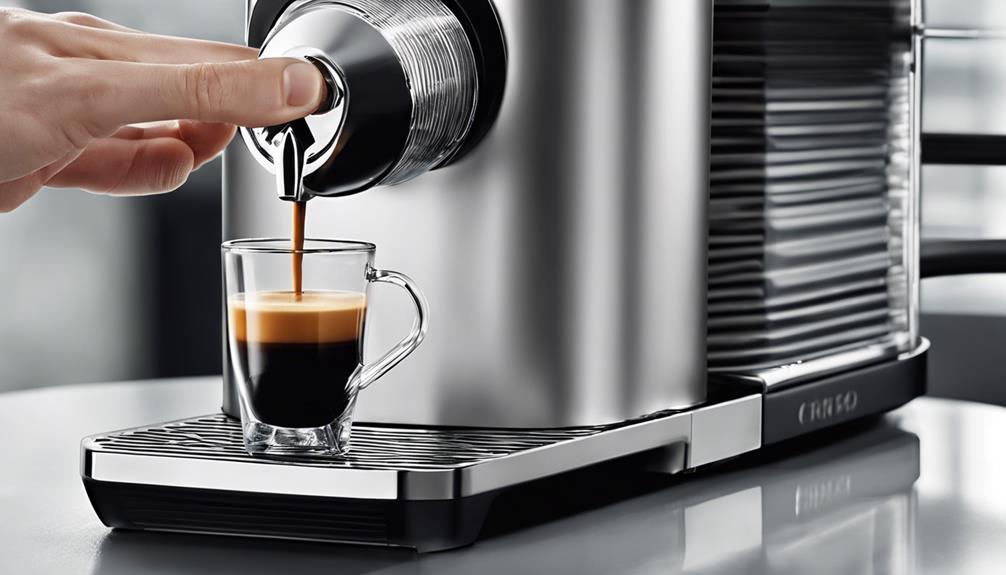
To complete the descaling process for your Nespresso machine, perform the final rinse with fresh water to make certain all traces of descaling solution are thoroughly removed.
After the final drain, refill the water reservoir with fresh water. Let it flow through the machine to rinse out any lingering descaling solution. This step is vital to guarantee your machine is free from any leftover solution that could impact the taste of your coffee.
Once the final rinse is done, the Nespresso machine will automatically exit the descaling mode, signaling that the process is complete. It's like giving your machine a rejuvenating shower to wash away all the descaling solution remnants.
Proper rinsing ensures peak performance and prepares your Nespresso for regular use. So, let the water work its magic, and soon you'll be ready to brew your favorite cup of coffee without any descaling worries!
Frequently Asked Questions
How Do I Turn off Nespresso Descaling Mode?
To turn off Nespresso descaling mode, I press and hold the lungo button for at least 5 seconds. This action stops the blinking lights and restores normal operation swiftly. It's a simple process that quickly gets my Nespresso machine back to making delicious coffee.
How Do I Reset My Nespresso After Descaling?
After descaling my Nespresso, I confirm the process is complete and rinse with fresh water. To reset, I follow the manufacturer's instructions or press specific buttons for a set duration. Once done, my Nespresso is ready for use.
How Do I Get My Nespresso Vertuo Next Out of Descaling Mode?
To exit descaling mode on my Nespresso Vertuo Next, I press and hold the button for 20-30 seconds. Ensuring the machine is unplugged, I wait for it to respond and exit descaling mode. It's a simple fix for normal operation.
Why Is the Descaling Light Still Flashing After Descaling Nespresso?
The descaling light continues flashing after descaling Nespresso due to inadequate rinsing, leaving residual solution triggering the light. Thoroughly rinse with fresh water to eliminate all traces, ensuring components are dry for use.
Conclusion
So there you have it, removing the descaling mode from your Nespresso machine is as easy as 1, 2, 3! Just follow the simple steps outlined in this guide, and you'll be back to enjoying your favorite coffee in no time.
And if you're worried about messing up, don't sweat it! The visuals provided in the article will guide you every step of the way, making the process a piece of cake.
Happy brewing!
In the vast and diverse world of coffee, coffee alternatives, and tea, Olivia has found her calling. As an author and a dedicated coffee and tea aficionado, her work for Cappuccino Oracle reflects her profound love and understanding of the intricate complexities found within these beverages. Olivia’s passion for the subject serves as both a catalyst for her creativity and a connection point with her audience.
Olivia’s appreciation for coffee, coffee alternatives, and tea blossomed at an early age. She discovered that these beverages invigorated her senses and stimulated her creative spirit. From the nuanced flavors of single-origin roasts to the captivating narratives intertwined with coffee, coffee alternatives, and tea trade and culture, Olivia found an unlimited source of inspiration in her daily cup.
Her love for these beverages and her talent for storytelling eventually converged at Cappuccino Oracle. As an author, Olivia’s mission is to illuminate the intricate tapestry that makes up the world of coffee, coffee alternatives, and tea. Her articles span a diverse range of topics, encompassing everything from the unique flavors of different brews to the sociocultural history intertwined with their cultivation and consumption.
Nespresso
How to Turn Off Nespresso Descaling Mode in 3 Steps
Brew the perfect cup by learning how to exit Nespresso descaling mode in 3 simple steps – your coffee adventure awaits!
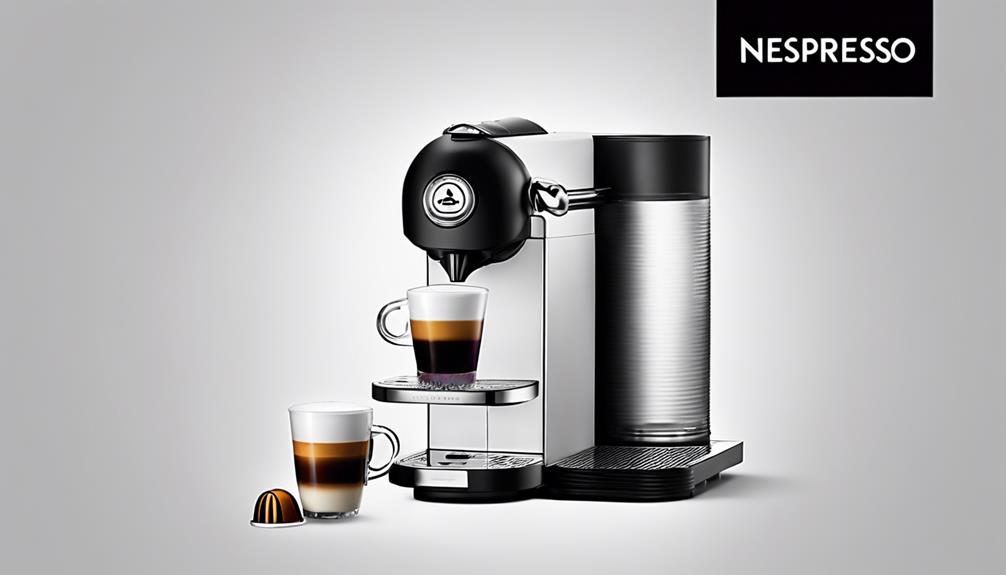
Let's get your Nespresso out of descaling mode in 3 simple steps. To begin with, press and hold the brew button for 7 seconds. Keep an eye out for that yellow light to know you're good to go. Next, secure and then release the lid with a satisfying click. It's like giving your Nespresso a secret handshake! Finally, repeat the descaling process until all the water drains out. Your machine will thank you for it! Ready to enjoy that perfect cup of coffee? These steps will have you sorted in no time! Let's get brewing!
Key Takeaways
- Press and hold brew button for 7 seconds.
- Confirm secure lid closure.
- Refill water reservoir.
- Ensure yellow light is on.
- Machine ready for normal operation.
Press and Hold Brew Button
To exit Nespresso descaling mode, simply press and hold the brew button for at least 7 seconds. This action is like hitting the essential button on your Nespresso machine after it's had a little spa treatment.
By holding down the brew button, you're telling your machine, 'Hey, I'm ready to get back to brewing those delicious cups of coffee.' It's the final step in the descaling process, ensuring your Nespresso is free from any limescale buildup that might be slowing down its performance.
Once you press and hold that button, you'll see the yellow light indicating that your machine is ready to exit the descaling mode and get back to business. Remember, this step is vital to maintaining your Nespresso machine's health and longevity, so don't skip it!
After you've held the brew button, your Nespresso will do a little happy dance (okay, not really) to complete the descaling process and be all set for your next coffee brewing adventure. Don't forget to refill the water reservoir before you start brewing again!
Lock and Unlock Lid
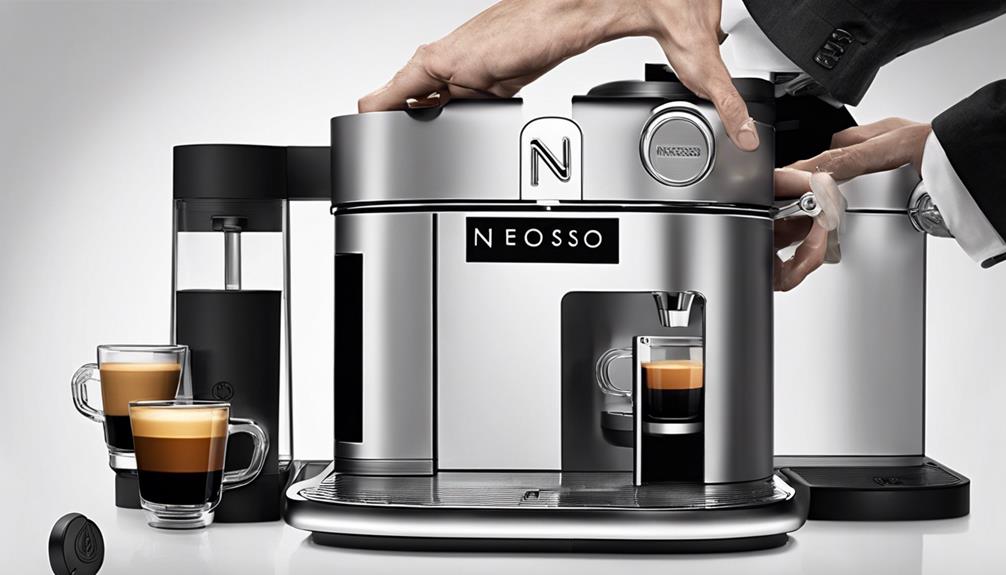
Securing and releasing the lid of the Nespresso machine is an important step in moving out of descaling mode. When it's time to secure and confirm the lid, it's like giving your Nespresso machine a little high-five to let it know it's done with descaling mode! This action not only resets the machine's sensors but also signals the completion of the descaling process. Think of it as a secret handshake between you and your Nespresso buddy.
To secure the lid, simply place it back in position and twist it until you hear a satisfying click. This confirms everything is snug and ready to go. When confirming, give it a twist in the opposite direction and lift it gently. It's like saying, 'You did great, now it's time to shine again!' Making sure the lid is securely in place after confirming guarantees your Nespresso machine is set for its next brewing adventure. So, secure, confirm, and get ready to brew your favorite cup of coffee!
Repeat Until Water Drains
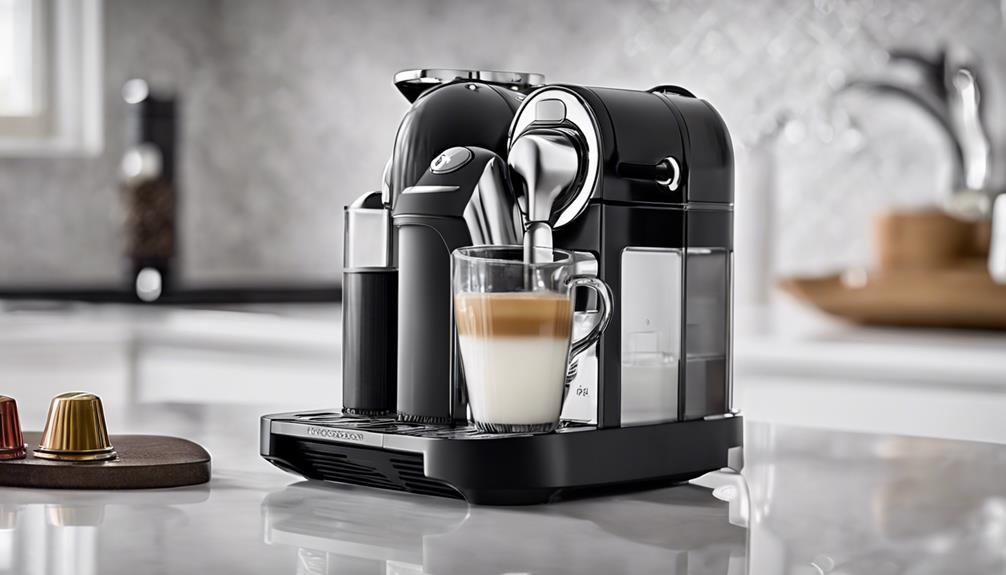
After confirming the lid is securely in place, proceed to repeat the descaling process until the water drains completely from the Nespresso machine.
It can be frustrating when your Vertuo Plus seems stuck in descaling mode, but don't worry, we've you protected!
If you find there's still a lot of water left in the machine, it's important to keep going until it's all out.
This step is vital to guarantee your Nespresso machine is properly descaled and ready for your next delicious brew.
Frequently Asked Questions
How Do I Get My Nespresso Out of Descaling Mode?
To exit descaling mode on my Nespresso, I follow the red light indicators and let the process complete naturally. Overheating should be avoided. If issues persist, I contact Nespresso support. A factory reset might not resolve the problem.
How Do I Reset My Nespresso After Descaling?
After descaling my Nespresso, I guarantee completion following the manual. If the machine doesn't exit descaling mode, a quick restart usually does the trick. If issues persist, I contact Nespresso for further assistance.
How Do I Stop My Nespresso Expert From Descaling?
Stopping my Nespresso Expert from descaling is simple. I wait until the descaling process finishes, ensuring the machine exits descaling mode automatically. Following the prompts and lights is key. Interrupting could lead to issues, but Nespresso support can help if problems persist.
Why Is My Nespresso Descaling Light Still on After Descaling?
My Nespresso descaling light persists after descaling due to incomplete cycles or sensor issues. I guarantee proper descaling steps, check for remaining solution triggering the light, and reach out to Nespresso support if needed. Peak machine performance is key.
Conclusion
And that's all there's to it! By following these simple steps, you can easily turn off the descaling mode on your Nespresso machine.
Just press and hold the brew button, secure and release the lid, and repeat until the water drains. It's like a little dance for your coffee maker!
So go ahead, give it a try and get back to enjoying your favorite Nespresso drinks without any interruptions. Cheers to hassle-free brewing!
In the vast and diverse world of coffee, coffee alternatives, and tea, Olivia has found her calling. As an author and a dedicated coffee and tea aficionado, her work for Cappuccino Oracle reflects her profound love and understanding of the intricate complexities found within these beverages. Olivia’s passion for the subject serves as both a catalyst for her creativity and a connection point with her audience.
Olivia’s appreciation for coffee, coffee alternatives, and tea blossomed at an early age. She discovered that these beverages invigorated her senses and stimulated her creative spirit. From the nuanced flavors of single-origin roasts to the captivating narratives intertwined with coffee, coffee alternatives, and tea trade and culture, Olivia found an unlimited source of inspiration in her daily cup.
Her love for these beverages and her talent for storytelling eventually converged at Cappuccino Oracle. As an author, Olivia’s mission is to illuminate the intricate tapestry that makes up the world of coffee, coffee alternatives, and tea. Her articles span a diverse range of topics, encompassing everything from the unique flavors of different brews to the sociocultural history intertwined with their cultivation and consumption.
-

 Mushroom Coffee3 weeks ago
Mushroom Coffee3 weeks agoYour Ultimate Guide to Ryze Mushroom Coffee: 9 Things to Know
-

 Mushroom Coffee3 weeks ago
Mushroom Coffee3 weeks agoUnveiling the Puzzle: Top 10 Alternatives to Ryze Mushroom Coffee Revealed
-

 Mushroom Coffee3 weeks ago
Mushroom Coffee3 weeks agoUnveiling the Mysteries of Ryze Mushroom Coffee: Top 10 Questions Answered
-

 Rooibos3 weeks ago
Rooibos3 weeks ago9 Essential Steps to Perfect Rooibos Tea: A Brewing Guide
-

 Coffee Basics4 weeks ago
Coffee Basics4 weeks agoHow Do Starbucks’ Seasonal Specialties Appeal to Customers?
-

 Mushroom Coffee3 weeks ago
Mushroom Coffee3 weeks ago3 Best Techniques to Brew Ryze Mushroom Coffee
-

 Turmeric Tea2 weeks ago
Turmeric Tea2 weeks agoTurmeric Ginger, Cinnamon, Lemon, Honey Tea Benefits
-

 Mushroom Coffee3 weeks ago
Mushroom Coffee3 weeks agoIs Ryze Mushroom Coffee’s Caffeine Content More like Decaf or Regular Coffee?

















